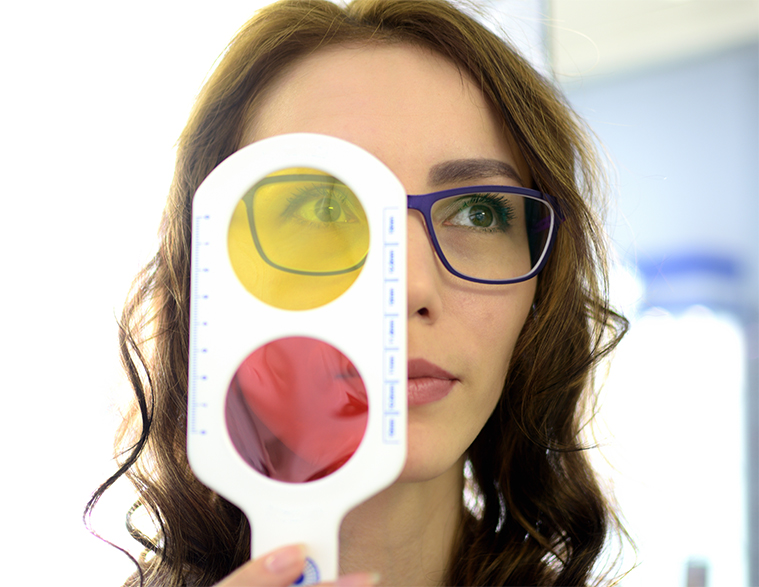Colour Blindness Test Auckland: Discover a Brighter Way to See with EnChroma Lenses

For people with colour vision deficiency, the world can sometimes look dull or confusing. Reds and greens might blend together, bright colours can appear muted, and small details in a vibrant landscape may go completely unnoticed. This condition is more common than most people realise, affecting roughly 1 in 12 men and 1 in 200 women in some form.
At Nvision Eyecare, we help patients across Auckland understand their unique colour vision and explore new ways to experience the world. One of the most exciting developments in this field is EnChroma® lens technology. These are specially designed glasses that can enhance colour contrast and help many people with red-green colour blindness see shades and hues they have never perceived before.
If you have ever been curious about what you might be missing or have been told you are colour blind, a professional colour blindness test can provide clear answers. An in-clinic trial of EnChroma lenses could even change the way you see the world forever.
What Is Colour Vision Deficiency? Understanding How It Affects Everyday Life
A common misconception about colour blindness is that it means seeing the world in black and white. In reality, this is extremely rare. The vast majority of people with colour vision deficiency (CVD) do see colours, but they have difficulty distinguishing between certain shades. The most common form is red-green colour deficiency, where reds, greens, browns, and oranges can look similar or muted.
This condition occurs when the colour-sensing cells in the retina, known as cones, do not function correctly. We have three types of cones, each one sensitive to red, green, or blue light. In a person with CVD, one or more of these cone types may be faulty or overlapping in their light sensitivity. This "confuses" the brain, making it hard to tell certain colours apart.
While it may not seem like a major issue, CVD can affect everyday life in many subtle but significant ways.
Simple Daily Tasks: Choosing clothes that match, telling if fruit is ripe, or knowing if meat is cooked properly can become frustrating guessing games.
Work and School: Many educational materials, presentations, and charts rely on colour-coding. A student might struggle to read a colour-coded graph, or an electrician could have trouble identifying correctly coloured wires. Careers in fields like design, art, and even aviation can be challenging for those with significant CVD.
Safety and Navigation: Interpreting traffic lights, reading colour-coded maps, or seeing warning signals can be difficult. A red warning light on a dashboard might blend into the background, or the colours on a weather map might be impossible to decipher.
Enjoying Nature and Art: The full beauty of a sunset, the vibrant colours of a flower garden, or the subtle shades in a painting might be lost. Many people with CVD do not even realise the richness of the colours they are missing until they experience it.
Understanding that colour vision deficiency is not a lack of vision but a different way of seeing is the first step. With the right tools and support, many of these daily challenges can be overcome.
How EnChroma Lenses Help You See the World in Full Colour
EnChroma lenses are a revolutionary advancement in eyewear, offering a life-changing experience for many people with red-green colour vision deficiency. They are not a "cure" for colour blindness, but they are a powerful tool that can dramatically improve colour perception and vibrancy.
The science behind EnChroma is surprisingly elegant. The lenses work by using a specialised optical filter that selectively removes specific wavelengths of light where the red and green cone cells have an overlapping response. Think of it like a sound engineer filtering out background noise to make a speaker's voice clearer. By filtering out these confusing wavelengths, the lenses help to create a more accurate and distinct signal from the red and green cones.
This separation of signals allows the brain to receive clearer information, resulting in a greater distinction between colours. For many wearers, colours that once appeared muddled or brownish, like reds and greens, suddenly become more saturated and vibrant. They may see different shades of purple for the first time or notice the bright green of a traffic light instead of a pale white.
It is important to set realistic expectations. The effect of EnChroma glasses varies from person to person. The results depend on the specific type and severity of an individual's colour vision deficiency. For some, the change is immediate and profound. For others, it is a more subtle improvement, or their brain may need time to adapt to the new visual information. This is why a professional assessment and in-clinic trial are so important to determine if EnChroma is the right solution for you.
Who Can Benefit from EnChroma Glasses?
EnChroma lenses are designed specifically for the most common types of colour vision deficiency: deuteranomaly and protanomaly, which are both forms of red-green colour blindness. These conditions account for over 99% of all cases of CVD.
The ideal candidates for EnChroma glasses are individuals with mild to moderate forms of these deficiencies.
Deuteranomaly (Green-Weak): This is the most common type of CVD. People with deuteranomaly have green-sensitive cones that are not functioning correctly, causing them to perceive greens, yellows, oranges, and reds as similar.
Protanomaly (Red-Weak): In this case, the red-sensitive cones are faulty. This makes reds look more like green and appear less bright.
For individuals with these conditions, EnChroma lenses can make a significant difference. They can help with everything from seeing the colours in a garden to improving confidence in situations where colour identification is important. We have helped many people on the North Shore, from students to professionals, discover the benefits of these lenses.
It is important to note that EnChroma lenses are not designed for individuals with deuteranopia or protanopia (where the green or red cones are missing entirely) or for those with blue-yellow colour deficiency (tritanomaly or tritanopia). While some people with these conditions may notice a minor enhancement in contrast, the effect will not be as dramatic. This is why a proper colour vision test is the essential first step to determine your specific type of CVD and whether you are a good candidate for EnChroma.

Experience Colour Vision Testing and EnChroma Trials at Nvision Eyecare
If you have ever wondered if you could be seeing more colours, the best way to find out is through a professional assessment. At Nvision Eyecare, we offer comprehensive colour vision testing and in-clinic EnChroma trials to help you explore your options in a supportive and expert environment.
As an independent optometry practice in Rosedale on Auckland’s North Shore, we are not just a retailer. We are clinical specialists dedicated to finding the best visual solution for each individual. Our process is thorough and patient-focused. We use standardised, clinical-grade tests to accurately diagnose the type and severity of your colour vision deficiency. This goes far beyond the simple online tests, which can often be inaccurate or misleading.
During your appointment, you will have the opportunity to try on EnChroma lenses right here in our clinic. You can walk around, look at different coloured objects, and even step outside to see how the lenses perform in natural daylight. Our experienced team will guide you through the process, helping you understand what you are seeing and what to expect. We provide personalised fitting guidance to ensure you choose the right frame and lens type for your lifestyle, whether for everyday wear or specific activities.
Real Stories: Seeing Colour for the First Time
The impact of seeing colour clearly for the first time can be an emotional and unforgettable experience. While every person's journey is unique, we have been privileged to witness some truly amazing moments in our clinic.
We recently worked with a high school student from the North Shore who had always struggled in art class. He knew he had some form of colour blindness but had accepted it as a limitation he had to live with. His parents booked him an EnChroma trial at Nvision Eyecare, hoping it might make a small difference.
During the assessment, he put on the EnChroma glasses and looked at a set of coloured pencils on the table. He was quiet for a moment, then looked up with a sense of awe. He could finally distinguish the bright, fiery red from the deep, rich green. He pointed to a purple pencil and said he had never seen a colour like that before; it had always just looked blue to him. The experience was about more than just seeing colours—it was about opening up a new way of interacting with the world, boosting his confidence for school and beyond.
These are the moments that drive our passion for providing specialised vision solutions. For many, it is not just about seeing colour; it is about seeing what they have been missing.
What to Expect During Your Colour Vision Assessment
Coming in for a colour vision assessment at Nvision Eyecare is a straightforward and informative process. We have designed our appointments to be educational and pressure-free, ensuring you leave with a clear understanding of your vision and your options. Here is a step-by-step look at what you can expect:
Initial Assessment and Discussion: We begin by talking with you about your experiences. Have you had trouble with colours? What have you noticed in your daily life? We then conduct a series of clinical colour vision tests, including the Ishihara test, which uses patterns of coloured dots to identify your specific type of CVD. This provides us with an accurate diagnosis.
In-Clinic Lens Trial: Based on your results, if you are a candidate, we will move on to the EnChroma trial. You will get to try on different types of EnChroma lenses (for indoor and outdoor use) and experience the effects for yourself. We have a variety of colour charts, images, and real-world objects in our Rosedale clinic for you to look at. We encourage you to take your time and see how your perception changes.
Discussion of Results and Options: After the trial, our optometrist will sit down with you to discuss your experience. We will talk about the level of improvement you noticed and answer any questions you have. We will provide honest, expert advice on whether EnChroma glasses are a worthwhile investment for you and discuss the different lens and frame options available.
Advice on Use and Care: If you decide to proceed with EnChroma glasses, we will provide you with all the information you need. This includes advice on how to adapt to the lenses, as it can take some time for your brain to get used to the new visual information. We will also cover proper care to ensure your new glasses last for years to come.
Our goal is to empower you with knowledge so you can make the best decision for your vision and lifestyle.
See the Difference for Yourself at NVISION
Colour vision testing is more than just an exercise in curiosity. For many, it is the first step toward seeing the world with greater clarity, confidence, and vibrancy. With a proper diagnosis and the right technology, you may be able to discover a richer, more vivid view of your everyday life.
At Nvision Eyecare, our colour vision specialists in Rosedale offer accurate testing, official EnChroma lens trials, and expert guidance to help you find the best solution for your unique needs. We are dedicated to helping our patients across Auckland and the North Shore experience their best possible vision.
Book a colour vision test or EnChroma trial at Nvision Eyecare—and see colours the way they were meant to be seen. Our Auckland clinic offers trusted testing and professional advice for all types of colour vision deficiency. Let us help you see the world in a whole new light.

